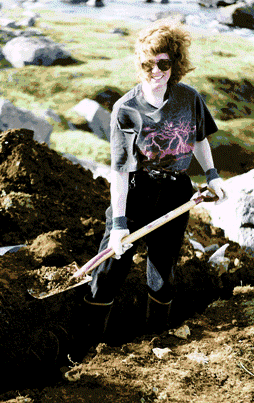
Gillian Foulger, whose Plates Plumes & Popper article kicked it off, draws her conclusions from the Great Plume Debate
In reaction to an in-your-face article suggesting a non-plume model for Iceland, which Sue Bowler had the singular guts to publish in Astronomy & Geophysics (December 2002(1)), Ted Nield emailed me asking me to write a "lively and teasing statement of belief" about plumes for Geoscientist, to kick off a debate.
The result was
Plumes, Plates and Popper (2). Over the following six months, ~ 30 contributions to the debate flooded in from scientists from seven countries. For once, everyone had the rare opportunity to say exactly what he thought.
The Geological Society Web Site debate has effectively raised awareness in the Earth science community as a whole that whether plumes exist or not is actually a question. This was illustrated by what I consider to be one of the more telling statements made in this debate, by Andy Saunders, who wrote
"Do mantle plumes exist? This time last year I would have said "yes, of course" ... Now I find my certainties tested ..." (3).
A fundamental objective of the pro-alternatives lobby is to bring about the happy state where it is no longer acceptable to publish a paper that begins by assuming a plume underlies the study area, describes the data, and finishes by concluding what the data tell us about that particular plume. If progress is to be made, we must stop saying "the X plume", just as scientists had to stop saying "phlogiston" before progress could be made in understanding combustion. If the plume assumption is dropped, and defence of the preferred model required, whether it is thermal or otherwise, then the truth must surely eventually come out. Apply correct scientific method, and new discoveries are bound to emerge.
The task of debate is now well underway. Most Earth scientists who pay attention to current research must by now be aware that the existence of plumes is under scrutiny. A number of formal, oral debates are being planned. It would be nice if scientists would now move on and start designing and conducting experiments that are capable of addressing this question, rather than experiments that are not. A necessary pre-requisite is a clear a priori definition of what a plume is, rather than an a posteriori one, and a statement regarding how the hypothesis may be tested. Promising avenues of approach are mantle convection models that correctly take account of the effects of pressure on the physical properties of rocks, seismic anisotropy, which can reveal the orientation of flow in the mantle, and improving geothermometry. Papers reporting non-diagnostic results should present the full suite of possible interpretations rather than a small subset.
Journals need to be more open to daring new ideas. Notwithstanding accusations of "whining" about the difficulties of getting provocative papers published, those of us working in this field have first-hand experience that such difficulties exist. A paper questioning the existence of plumes in general, or at particular a "hot spot" must often be either stripped of its radical content or submitted to three or four journals before it is accepted. I recently received a paper for review with a cover letter that stated "Please do not recommend rejection solely because you think the views expressed are not likely to be widely shared. Geophysical Journal International welcomes provocative papers and responsibility for a paper rests with its author". This is an excellent development, and if more journals adopted such a policy, they might make much more interesting reading and stimulate rebuttals and debate. The scientific literature might then return to being a vehicle that facilitates the most rapid scientific progress possible, rather than functioning largely as a data repository.
We should also resolve to do better by our students, and teach them to be critical rather than accepting current wisdom. A class of graduating students was once told that the good news was that half of what their course taught was right, but that the bad news was that it was unknown which half. In future we should tell this to registering freshers rather than graduating finalists.
I finish by extending my thanks to the Geological Society of London for performing a pivotal service to the Earth science community in hosting this debate, and to everyone who took the time and trouble to contribute. Most of all, we all owe Ted Nield a huge vote of thanks for his tremendous work on this project, and for the wicked humour and irreverence with which he suitably spiced this attack on an icon.
Notwithstanding his 31 October date for closure of the debate, Ted has been prevailed upon to allow it to continue, focusing on the subject of large igneous provinces and whether or not they represent the arrival of plume heads.
So don't go away! Rather, pick up those pens again before Ted discovers the pleasures of catching up on missed sleep. *
* Ted Nield notes: The LIPs debate never really took off, so I did catch up on most sleep after all.